Started in 2013, Complete George now comprises two hundred organizations, communities and electeds who’ve called on the Port Authority of New York & New Jersey to widen the bikeways across the George Washington Bridge.
Remarks to PANYNJ, 9/21/23 – Manhattan Bridge
Opinion: The GWB’s Revamped Bike-Ped Paths are Not Enough, StreetsBlog, 2/14/23
North (South) Path Plan
Ten Ways “Restore the George” Gets it Wrong
GWB Reconstruction Misses Mark on Sustainability – RPA Blog
PANYNJ press release on NorthWalk opening
Current GWB Path Current GWB. (1) 7′ path for pedestrians, runners and cyclists. Photo by Hassan Diop.
Current GWB. (1) 7′ path for pedestrians, runners and cyclists. Photo by Hassan Diop.
Between 2018 and 2027, the Port Authority of New York & New Jersey will rip out and restore the 1931-era, 7 foot paths on the George Washington Bridge as part of a $1.9 billion program to Restore the George.
The George is the sole bike-able connector between North Jersey and NYC. Its paths are already dangerously overcrowded at 3700 cyclists per day. If the paths aren’t widened to comply with national standards (AASHTO), the George will become a walk-your-bikes facility.
This will hobble the growth of cycling across the region for generations, impacting durable enhancements to tourism, public health, affordability, competitiveness, sustainability and resilience annually worth hundreds of millions of dollars.
- For six months in 2015, NYCDOT recorded an average 3700 trips per day on weekends, making the GWB the #3 most heavily biked bridge in NYC.
- Also, the fastest growing at 10.4% per year between 2010 and 2015.
- Yet at 7 foot wide, the George has by far the narrowest path.
 Data sources: NYCDOT and PANYNJ. Measurements by Neile Weissman.
Data sources: NYCDOT and PANYNJ. Measurements by Neile Weissman.
- Between 2010 and 2015, bike trips across NYC overall grew 12.5%, driven by expansion of its bike grid and the debut of bike share.
- At 521 users per hour, travel across the GWB paths well exceeds AASHTO‘s 300 user-per-hour threshold to widen the paths to 14 foot.
- Remarkably, this growth has occurred on a facility with an FHWA level of service of “F – Failing“.
Port Authority’s ADA-compliant Plan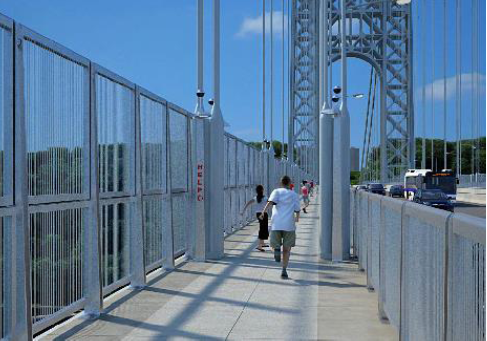 Port Authority’s Plan: (1) 7′ path for peds-runners. (1) 7′ path for cyclists. 11′ high anti-suicide barrier. Rendering by Amman & Whitney.
Port Authority’s Plan: (1) 7′ path for peds-runners. (1) 7′ path for cyclists. 11′ high anti-suicide barrier. Rendering by Amman & Whitney.
The PA’s “Restore the George” plan for the paths would:
- Replace stairs on the North Path with ramps.
- Widen the NY-NJ approaches.
- Assign one path to pedestrians-runners and another to bicyclists.
- Restore paths on the mile-long span to 7 foot, in compliance with ADA.
Unfortunately, PA’s plan won’t improve the GWB’s current level of service.
- Peds-runners comprise just 25% of current peak use.
- 5-10% of pedestrians and runners will still use the bike path.
- Melt-refreeze of snow accumulation will continue to restrict winter access.
- Safety barriers will obstruct views of city skylines and the Palisades.
- ADA won’t insulate the PA from liability in crashes involving cyclists.
- If current levels of growth sustain, its grade will remain “F – Failing”.
Complete George’s AASHTO-compliant proposal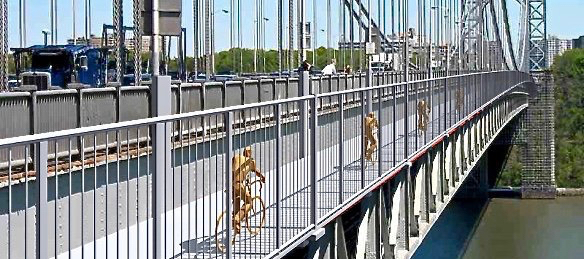 Complete George: (2) 10′ paths for cyclists plus (2) 7′ paths for peds-runners. 9′ high anti-suicide barrier. Rendering by Joseph Lertola.
Complete George: (2) 10′ paths for cyclists plus (2) 7′ paths for peds-runners. 9′ high anti-suicide barrier. Rendering by Joseph Lertola.
Complete George’s AASHTO-compliant proposal would cantilever a pair of 10 foot bikeways and safety barriers below the existing 7 foot paths which would both be reserved for pedestrians and runners.
- This would result in four paths totaling 33.5 foot.
- It would maintain unobstructed views of pedestrians and runners.
- No cables intruding on bikeways allow them to be fully snowplowed.
- Increased capacity would be available as soon as 2021.
- AASHTO-compliant paths insulate the PA from liability.
- FHWA grade for this proposal in 2025 will be “A – Excellent“.
Connectivity
The George is the sole bike-able Hudson crossing between ten million residents of North Jersey and NYC. It is the linchpin to the 1650 mile Tri-State Trail Network. And it connects the two most heavily biked roads in the country, Hudson Greenway and Route 9W. One could characterize restoring the GWB paths as walkways as “connecting two firehoses with a straw.”
 Heat map of Hudson Greenway> GWB> Route 9W. Image Strava.
Heat map of Hudson Greenway> GWB> Route 9W. Image Strava.
 GWB is sole connector for 1650-mile Tri-State Trail network. Image RPA.
GWB is sole connector for 1650-mile Tri-State Trail network. Image RPA.
A “complete” George will spur implementation of plans to connect Bergen parks with a bike grid and NYCDOT plans to expand bike access over seven Harlem River Bridges, across Bronx “transportation deserts.”
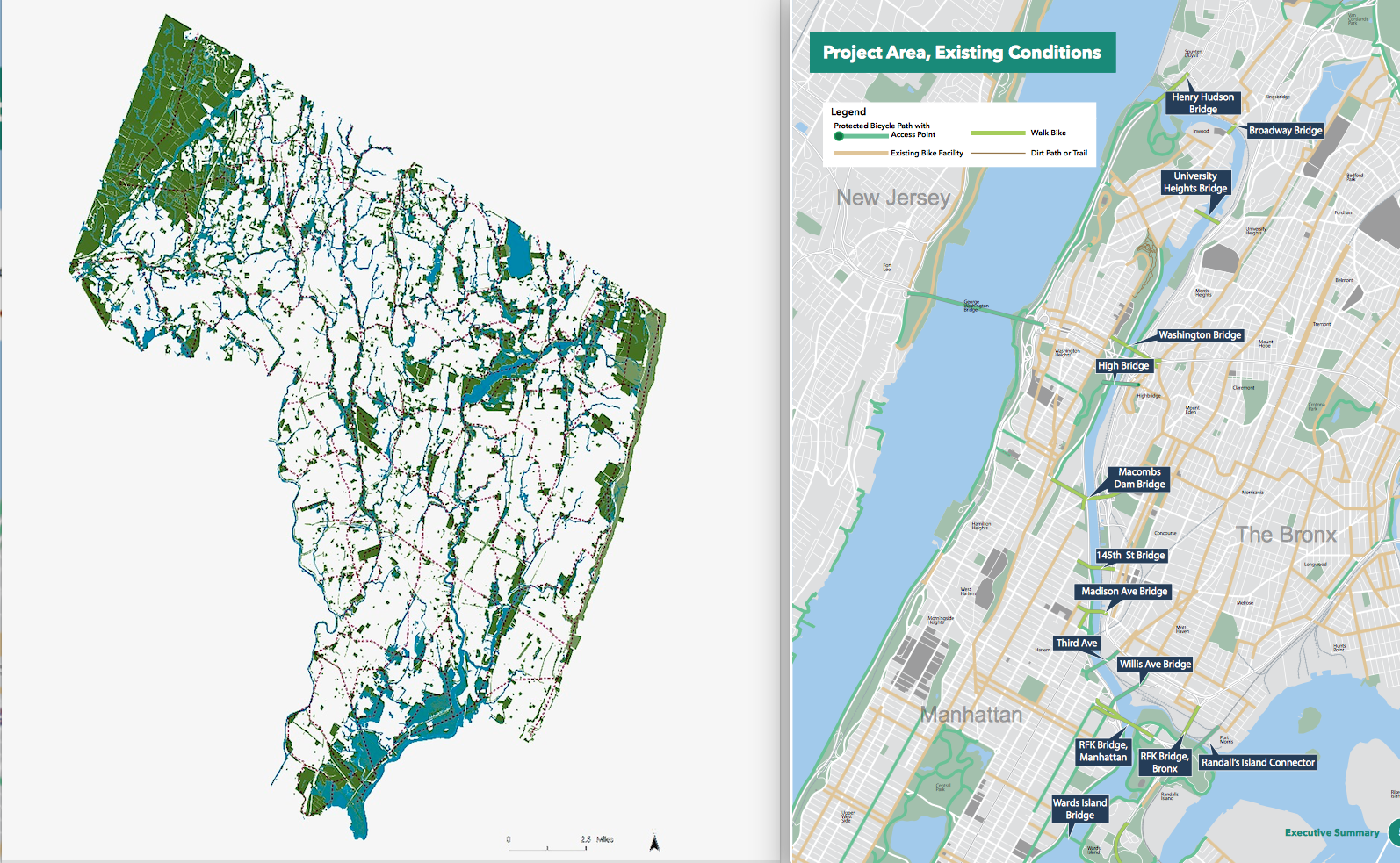 Images Rutgers CUES and NYC DOT/AECOM.
Images Rutgers CUES and NYC DOT/AECOM.
NY City houses 800,00 adult cyclists with no recreational facilities not shared with pedestrians. The GWB represents their sole access to bike-able roads and green space west of the Hudson. These cyclists represent a huge, captive market for tourism across the Low-Mid Hudson Valley.
A Rutgers report stated biking and walking added $497 million to NJ’s economy in 2011.
In tandem with the Mario M. Cuomo Bridge, the George would form a forty mile loop, drawing cyclists from across the region.
The Mario M. Cuomo, Kosciuszko Bridges and Empire State Trail represent half a billion invested in cycling across lower New York. But cycle tourism here could well decline if the single bikeable Hudson crossing out of NYC ceased to function as a cycling facility.
Based on models developed for Walkway Over the Hudson, a linear park across the GWB – with unobstructed views of city skylines and the Palisades and discrete paths for pedestrians, runners and cyclists – would annually attract 290,00 visitors, spending $42 million and sustaining 675 jobs.
 Walkway over the Hudson connecting Dutchess and Ulster Counties. Image WOTH.
Walkway over the Hudson connecting Dutchess and Ulster Counties. Image WOTH.
Public Health
A World Health Organization model shows the increase in physical activity spawned by wider GWB paths would reduce mortality by 21 deaths per year saving $195 million.
Doctors from the Columbia School of Public Health similarly determined wider paths would reduce morbidity at $883 per quality adjusted life year (QALY) – that’s 14 times more cost-effective as a public health intervention than vaccinating kids against the flu.
Sustainability
With the transportation sector overtaking power generation as lead emitter of CO2, the PA must include tenants and customers in its 80 by 50 greenhouse gas reduction goals. Widening the GWB paths to support cycling’s growth is its most cost effective option.
Organizations adapting to a Two-Degree World face three channels of risk: physical, liability and transitional. The Port Authority is starkly vulnerable to all three. Diversifying its portfolio with assets whose use reduce emissions diversifies that risk.
On the occasion of the UN Climate Action Summit, the Port Authority must reassess its role it reducing regional emissions, particularly its $30 billion investment in its airports.
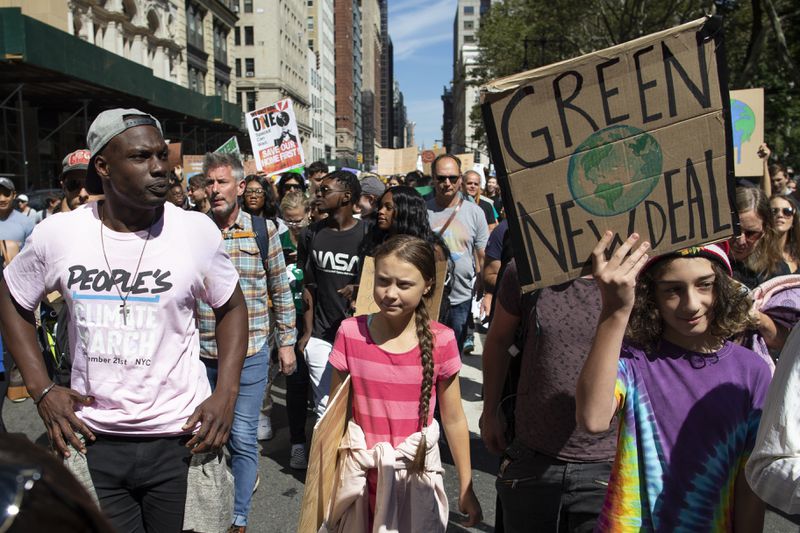 New York City Climate March, 9/20/19. Image New York Daily News.
New York City Climate March, 9/20/19. Image New York Daily News.
Resilience
Should we lose the Hudson rail tunnels before replacement tunnels can be built, wider GWB paths would support 20,000 bike commuters per day, similar to how the Williamsburg Bridge would have mitigated shutdown of the L subway. If included in the ongoing restorations, new capacity would be online by 2021.
 Williamsburg Bridge. Image Bowery Boogie.
Williamsburg Bridge. Image Bowery Boogie.
On September 2018, an overhead bracket pierced the roof of a NJ Transit train. Had that incident resulted in loss of life, those tunnels would have been closed for a very long time.
Environmental Justice
Key beneficiaries of wider paths include communities who’ve borne the brunt of GWB congestion and degraded air quality for generations.
Transportation Equity
By widening the paths, the Port Authority would align itself with cities like Baltimore, and Los Angeles which will spend $4 billion over 40 years to extend cycling infrastructure to its “transportation deserts.”
The expansion of bike -ped capacity across the San Franciso-Oakland Bay Bridge provides a critical waterway link where no other option exists.
 San Francisco-Oakland Bay Bridge, East Span, Caltrans. Source, W. Mueller II.
San Francisco-Oakland Bay Bridge, East Span, Caltrans. Source, W. Mueller II.
The Regional Plan Association has called for reducing expenditures for housing, utilities and transportation from 51% of household income to 45% by 2040.
Commuting by bike saves thousands of dollars per year vs. mass transit or car.
Cycling reduces the need for off-street parking, which lowers the cost of affordable housing and frees up real estate near transport hubs for transit-oriented development.
 Percentage of income spent on housing and transport. Image Regional Plan Association.
Percentage of income spent on housing and transport. Image Regional Plan Association.
Cities across the U.S. market their cycling infrastructure to attract a millennial workforce. Twelve Amazon HQ2 finalists were ranked in Bicycling Magazine’s Top 50 U.S. Cities to Bike.
Multiple studies correlate increases in home prices to their proximity to bikeways. These range from 4% in Delaware to 23% in Chicago.
Crediting NYC’s thousand mile bike grid with a “Delaware” multiple, its current share of annual city property taxes would be $150 million.
If adding a robust trans-Hudson connector to that grid enhances it value another half a percent, the incremental revenue would be $15 million per year.
Portland, a city of 2 million, with a 6% bicycle mode share credits its bike grid with preventing $2.6 billion per year from leaving the city.
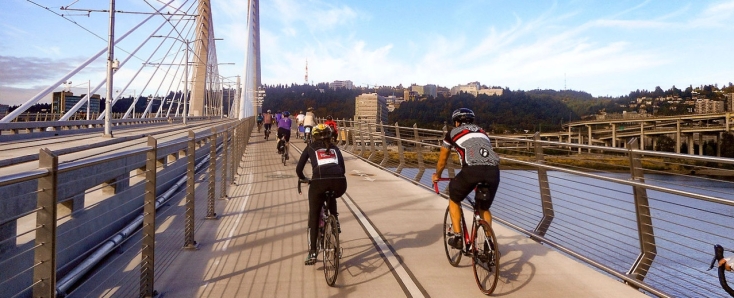 Tilikum Crossing, Portland. (2) 14′ paths. Cost $135 million. Image Tedder.
Tilikum Crossing, Portland. (2) 14′ paths. Cost $135 million. Image Tedder.
Tokyo, a city of 13 million, 90% use mass transit for their daily commute, including a third who bike the first-and-last mile. With real estate by train stations so expensive automated, seismic-resistant underground bicycle parking systems have been developed.
 Underground automated bike parking. Capacity for 200 bikes. Image Giken Corp.
Underground automated bike parking. Capacity for 200 bikes. Image Giken Corp.
London, whose size and population rivals New York City, spends $270 million per year on cycling infrastructure.
 Parking for 380 bicycles at Paddington Station, London. Image Cyclehoop.
Parking for 380 bicycles at Paddington Station, London. Image Cyclehoop.
Netherlands began building up its bicycle infrastructure during the oil crisis of the 70’s. This was also a period in which 400 children a year were being killed by cars. Today, cycling mode share nationwide is 31%, with some cities, over 50%. Utrecht boasts the worlds largest bike parking station with room for 12,500 bikes.
 Utrecht bike garage with room for 12,500 bikes. Image Bike Dutch.
Utrecht bike garage with room for 12,500 bikes. Image Bike Dutch.
Cost Comparisons
- $118 million to restore the GWB paths to a pedestrian 7 foot width (ADA)
- $39 million for Walkway over the Hudson
- $55 million for a bikeway on the Kosciuszko Bridge
- $60 million to renovate the High Bridge
- $90 million to widen GWB paths to national standards (AASHTO)
- $135 million for a bikeway on the Bayonne
- $135 million for a bikeway on the Goethals
- $400 million estimated to add bikeways to the Verrazzano
- $380 million, or 20% of the total $1.9 billion resoration, is what USDOT recommends to upgrade bike-ped paths on bridges during renovations.
- $440 million for a bikeway on the Mario M. Cuomo
Considering that its paths may need to sustain more trips than the other bridges combined, the GWB should be considered a “best buy.”
 High Bridge – Getty. Goethals Bridge – PANYNJ. Bayonne Bridge – Ramlogue.
High Bridge – Getty. Goethals Bridge – PANYNJ. Bayonne Bridge – Ramlogue.
Cost Savings
- It is less expensive and disruptive to accomplish the widening as part of the recabling than later as a standalone project.
- Historically low interest rates allow the PA to finance construction cheaply and without affecting their credit rating.
- Proceeding now saves decades’ worth of Construction Cost Index increases. Presuming 3% annual increase in the cost of construction, plus 2% inflation, the cost to widen the GWB paths grows from of $90 million in 2018 to $430 million in 2050.
 Construction Cost Index 1913-2013. Engineering News Record.
Construction Cost Index 1913-2013. Engineering News Record.
Press
- With Tunnel Repairs in the Offing, Bikes are Key in Keeping People on the Move – NJ Spotlight, 7/18
- Cyclists want improvements made to GWB – News 12 New Jersey, 4/18
- GWB Reconstruction Misses the Mark, Regional Plan Association, 7/17
- GWB project: 7 years, $2 billion, and one thing missing, Crain’s, 2/17
- I’m back and things have only gotten worse, Bike Snob, 2/17
- Help make the GWB in NYC Better for Cyclists, The Radavist, 1/17
- (Foot) traffic problems on the GWB, Brian Lehrer Show, WNYC 12/16
Two hundred organizations, businesses, communities and electeds have called on the PA to widen the GWB paths to comply with national standards as part of the ongoing reconstruction.
- “We would encourage the Port to continue to think aggressively about planning for adequate bike facilities in all of its projects. Specifically, about the long-term need for additional capacity on the George Washington crossing. – NYC Deputy Mayor, and former PANYNJ Executive Director, Anthony E. Shorris
- “As one of the densest metropolitan areas in America, we must commit to shore up 20th Century infrastructure that cannot keep up with the demands of the 21st Century.” – Eleven NY-NJ members of Congress
- “We ask (Gov. Cuomo) to call on the PA to widen the GWB paths as part of any state program to expand cycling infrastructure.” – Letter to Governor Cuomo signed by 15 NY State Senators and Assemblymembers
- “6,000 cyclists cross the GWB per weekend. This number will go up, not down.” – Orange County
- The closest Hudson River Crossing to CB4 which allows cycling is the GWB.” – Manhattan Community Board #4
- “The Borough has installed bike lanes, promoted bicycle safety and has served as the host community to bicycle races and similar functions. Widening the (GWB) paths would serve as a perfect compliment to improvements and policies that we, and neighboring communities, have implemented.” – Fort Lee, NJ
- Before construction begins, the (PA’s) plans must be revisited to ensure that this once-in-a-lifetime project is planned to optimum standards, not just good enough. – Transportation Alternatives
- “With new off-road opportunities opening up in Sterling Forest, Harriman State Park, paths that meet federal guidelines will insure that cyclists can commute to and from NYC with ease.” – International Mountain Bike Association (IMBA)
- “As a long-distance cycling club, we wholeheartedly support segregating the pedestrian walkways and widening the bicycling pathways of the GWB as part of the planned refurbishing of the span.” – Long Island Randonneurs
- “The plan to allocate one 7 foot path for peds-runners and another for cyclists will inevitably cause runners to move over to the cyclists’ path.” – NY Road Runners
- “Despite being the only bike route over the Hudson leaving NYC, the proposed 7-foot paths seem more like an afterthought than a true civic amenity.” – Regional Plan Association
Questions for the Port Authority
- If a 3700 cyclists per day is insufficient to warrant widening the paths now, then what is the PA’s threshold? How much more crowded does it need to get?
- If the PA regards the current cost of widening the paths too expensive, what’s the likelihood that a standalone job, at greater cost, will find acceptance later?
- If 250 organizations, businesses, communities and public officials aren’t enough of a constituency to get this project moving, then who is?
- DOTs broadly adhere to AASHTO for the design of shared use paths – to insure safety and adequate capacity, as well as to insulate themselves from liability. How can the PA continue to guarantee bicyclists access if it restores the paths to an ADA standard?
- How can the PA guarantee bicyclists continued access without the insulation from liability afforded by an AASHTO-compliant design.
- How will the PA’s path design support bike share? How many docking stations will the entrances accommodate? How will providers load-balance periods of peak use if cyclists are allocated a single 7 foot path?
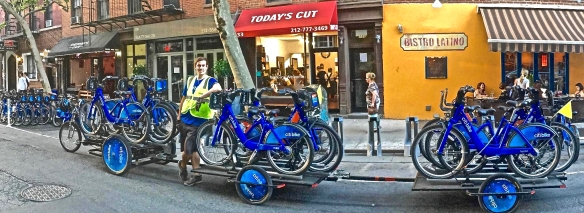 CitiBike 12-unit transporter. Photo by Susan Brennan.
CitiBike 12-unit transporter. Photo by Susan Brennan.
GW Bridge designers Othmar Ammann and Cass Gilbert envisioned the paths as a great public space. Original design drawings depict 16′ wide paths and portals and early use projections showed foot traffic growing faster than car trips.
 Rendering of GWB entrance with 16 foot wide pedestrian portals. Image Cass Gilbert.
Rendering of GWB entrance with 16 foot wide pedestrian portals. Image Cass Gilbert.
Opinion: The GWB’s Revamped Bike-Ped Paths are Not Enough, StreetsBlog, 2/14/23
NYS “One House” budget letter asking $60M to expand GWB South Path
Ten Ways “Restore the George” Gets it Wrong
GWB Reconstruction Misses Mark on Sustainability – RPA Blog
PANYNJ press release on NorthWalk opening
Started in 2013, Complete George now comprises two hundred organizations, communities and electeds who’ve called on the Port Authority of New York & New Jersey to widen the bikeways across the George Washington Bridge.
Current GWB Path Current GWB. (1) 7′ path for pedestrians, runners and cyclists. Photo by Hassan Diop.
Current GWB. (1) 7′ path for pedestrians, runners and cyclists. Photo by Hassan Diop.
Between 2018 and 2027, the Port Authority of New York & New Jersey will rip out and restore the 1931-era, 7 foot paths on the George Washington Bridge as part of a $1.9 billion program to Restore the George.
The George is the sole bike-able connector between North Jersey and NYC. Its paths are already dangerously overcrowded at 3700 cyclists per day. If the paths aren’t widened to comply with national standards (AASHTO), the George will become a walk-your-bikes facility.
This will hobble the growth of cycling across the region for generations, impacting durable enhancements to tourism, public health, affordability, competitiveness, sustainability and resilience annually worth hundreds of millions of dollars.
- For six months in 2015, NYCDOT recorded an average 3700 trips per day on weekends, making the GWB the #3 most heavily biked bridge in NYC.
- Also, the fastest growing at 10.4% per year between 2010 and 2015.
- Yet at 7 foot wide, the George has by far the narrowest path.
 Data sources: NYCDOT and PANYNJ. Measurements by Neile Weissman.
Data sources: NYCDOT and PANYNJ. Measurements by Neile Weissman.
- Between 2010 and 2015, bike trips across NYC overall grew 12.5%, driven by expansion of its bike grid and the debut of bike share.
- At 521 users per hour, travel across the GWB paths well exceeds AASHTO‘s 300 user-per-hour threshold to widen the paths to 14 foot.
- Remarkably, this growth has occurred on a facility with an FHWA level of service of “F – Failing“.
Port Authority’s ADA-compliant Plan Port Authority’s Plan: (1) 7′ path for peds-runners. (1) 7′ path for cyclists. 11′ high anti-suicide barrier. Rendering by Amman & Whitney.
Port Authority’s Plan: (1) 7′ path for peds-runners. (1) 7′ path for cyclists. 11′ high anti-suicide barrier. Rendering by Amman & Whitney.
The PA’s “Restore the George” plan for the paths would:
- Replace stairs on the North Path with ramps.
- Widen the NY-NJ approaches.
- Assign one path to pedestrians-runners and another to bicyclists.
- Restore paths on the mile-long span to 7 foot, in compliance with ADA.
Unfortunately, PA’s plan won’t improve the GWB’s current level of service.
- Peds-runners comprise just 25% of current peak use.
- 5-10% of pedestrians and runners will still use the bike path.
- Melt-refreeze of snow accumulation will continue to restrict winter access.
- Safety barriers will obstruct views of city skylines and the Palisades.
- ADA won’t insulate the PA from liability in crashes involving cyclists.
- If current levels of growth sustain, its grade will remain “F – Failing”.
Complete George’s AASHTO-compliant proposal Complete George: (2) 10′ paths for cyclists plus (2) 7′ paths for peds-runners. 9′ high anti-suicide barrier. Rendering by Joseph Lertola.
Complete George: (2) 10′ paths for cyclists plus (2) 7′ paths for peds-runners. 9′ high anti-suicide barrier. Rendering by Joseph Lertola.
Complete George’s AASHTO-compliant proposal would cantilever a pair of 10 foot bikeways and safety barriers below the existing 7 foot paths which would both be reserved for pedestrians and runners.
- This would result in four paths totaling 33.5 foot.
- It would maintain unobstructed views of pedestrians and runners.
- No cables intruding on bikeways allow them to be fully snowplowed.
- Increased capacity would be available as soon as 2021.
- AASHTO-compliant paths insulate the PA from liability.
- FHWA grade for this proposal in 2025 will be “A – Excellent“.
Connectivity
The George is the sole bike-able Hudson crossing between ten million residents of North Jersey and NYC. It is the linchpin to the 1650 mile Tri-State Trail Network. And it connects the two most heavily biked roads in the country, Hudson Greenway and Route 9W. One could characterize restoring the GWB paths as walkways as “connecting two firehoses with a straw.”
 Heat map of Hudson Greenway> GWB> Route 9W. Image Strava.
Heat map of Hudson Greenway> GWB> Route 9W. Image Strava.
 GWB is sole connector for 1650-mile Tri-State Trail network. Image RPA.
GWB is sole connector for 1650-mile Tri-State Trail network. Image RPA.
A “complete” George will spur implementation of plans to connect Bergen parks with a bike grid and NYCDOT plans to expand bike access over seven Harlem River Bridges, across Bronx “transportation deserts.”
 Images Rutgers CUES and NYC DOT/AECOM.
Images Rutgers CUES and NYC DOT/AECOM.
NY City houses 800,00 adult cyclists with no recreational facilities not shared with pedestrians. The GWB represents their sole access to bike-able roads and green space west of the Hudson. These cyclists represent a huge, captive market for tourism across the Low-Mid Hudson Valley.
A Rutgers report stated biking and walking added $497 million to NJ’s economy in 2011.
In tandem with the Mario M. Cuomo Bridge, the George would form a forty mile loop, drawing cyclists from across the region.
The Mario M. Cuomo, Kosciuszko Bridges and Empire State Trail represent half a billion invested in cycling across lower New York. But cycle tourism here could well decline if the single bikeable Hudson crossing out of NYC ceased to function as a cycling facility.
Based on models developed for Walkway Over the Hudson, a linear park across the GWB – with unobstructed views of city skylines and the Palisades and discrete paths for pedestrians, runners and cyclists – would annually attract 290,00 visitors, spending $42 million and sustaining 675 jobs.
 Walkway over the Hudson connecting Dutchess and Ulster Counties. Image WOTH.
Walkway over the Hudson connecting Dutchess and Ulster Counties. Image WOTH.
Public Health
A World Health Organization model shows the increase in physical activity spawned by wider GWB paths would reduce mortality by 21 deaths per year saving $195 million.
Doctors from the Columbia School of Public Health similarly determined wider paths would reduce morbidity at $883 per quality adjusted life year (QALY) – that’s 14 times more cost-effective as a public health intervention than vaccinating kids against the flu.
Sustainability
With the transportation sector overtaking power generation as lead emitter of CO2, the PA must include tenants and customers in its 80 by 50 greenhouse gas reduction goals. Widening the GWB paths to support cycling’s growth is its most cost effective option.
Organizations adapting to a Two-Degree World face three channels of risk: physical, liability and transitional. The Port Authority is starkly vulnerable to all three. Diversifying its portfolio with assets whose use reduce emissions diversifies that risk.
On the occasion of the UN Climate Action Summit, the Port Authority must reassess its role it reducing regional emissions, particularly its $30 billion investment in its airports.
 New York City Climate March, 9/20/19. Image New York Daily News.
New York City Climate March, 9/20/19. Image New York Daily News.
Resilience
Should we lose the Hudson rail tunnels before replacement tunnels can be built, wider GWB paths would support 20,000 bike commuters per day, similar to how the Williamsburg Bridge would have mitigated shutdown of the L subway. If included in the ongoing restorations, new capacity would be online by 2021.
 Williamsburg Bridge. Image Bowery Boogie.
Williamsburg Bridge. Image Bowery Boogie.
On September 2018, an overhead bracket pierced the roof of a NJ Transit train. Had that incident resulted in loss of life, those tunnels would have been closed for a very long time.
Environmental Justice
Key beneficiaries of wider paths include communities who’ve borne the brunt of GWB congestion and degraded air quality for generations.
Transportation Equity
By widening the paths, the Port Authority would align itself with cities like Baltimore, and Los Angeles which will spend $4 billion over 40 years to extend cycling infrastructure to its “transportation deserts.”
The expansion of bike -ped capacity across the San Franciso-Oakland Bay Bridge provides a critical waterway link where no other option exists.
 San Francisco-Oakland Bay Bridge, East Span, Caltrans. Source, W. Mueller II.
San Francisco-Oakland Bay Bridge, East Span, Caltrans. Source, W. Mueller II.
The Regional Plan Association has called for reducing expenditures for housing, utilities and transportation from 51% of household income to 45% by 2040.
Commuting by bike saves thousands of dollars per year vs. mass transit or car.
Cycling reduces the need for off-street parking, which lowers the cost of affordable housing and frees up real estate near transport hubs for transit-oriented development.
 Percentage of income spent on housing and transport. Image Regional Plan Association.
Percentage of income spent on housing and transport. Image Regional Plan Association.
Cities across the U.S. market their cycling infrastructure to attract a millennial workforce. Twelve Amazon HQ2 finalists were ranked in Bicycling Magazine’s Top 50 U.S. Cities to Bike.
Multiple studies correlate increases in home prices to their proximity to bikeways. These range from 4% in Delaware to 23% in Chicago.
Crediting NYC’s thousand mile bike grid with a “Delaware” multiple, its current share of annual city property taxes would be $150 million.
If adding a robust trans-Hudson connector to that grid enhances it value another half a percent, the incremental revenue would be $15 million per year.
Portland, a city of 2 million, with a 6% bicycle mode share credits its bike grid with preventing $2.6 billion per year from leaving the city.
 Tilikum Crossing, Portland. (2) 14′ paths. Cost $135 million. Image Tedder.
Tilikum Crossing, Portland. (2) 14′ paths. Cost $135 million. Image Tedder.
Tokyo, a city of 13 million, 90% use mass transit for their daily commute, including a third who bike the first-and-last mile. With real estate by train stations so expensive automated, seismic-resistant underground bicycle parking systems have been developed.
 Underground automated bike parking. Capacity for 200 bikes. Image Giken Corp.
Underground automated bike parking. Capacity for 200 bikes. Image Giken Corp.
London, whose size and population rivals New York City, spends $270 million per year on cycling infrastructure.
 Parking for 380 bicycles at Paddington Station, London. Image Cyclehoop.
Parking for 380 bicycles at Paddington Station, London. Image Cyclehoop.
Netherlands began building up its bicycle infrastructure during the oil crisis of the 70’s. This was also a period in which 400 children a year were being killed by cars. Today, cycling mode share nationwide is 31%, with some cities, over 50%. Utrecht boasts the worlds largest bike parking station with room for 12,500 bikes.
 Utrecht bike garage with room for 12,500 bikes. Image Bike Dutch.
Utrecht bike garage with room for 12,500 bikes. Image Bike Dutch.
Cost Comparisons
- $118 million to restore the GWB paths to a pedestrian 7 foot width (ADA)
- $39 million for Walkway over the Hudson
- $55 million for a bikeway on the Kosciuszko Bridge
- $60 million to renovate the High Bridge
- $90 million to widen GWB paths to national standards (AASHTO)
- $135 million for a bikeway on the Bayonne
- $135 million for a bikeway on the Goethals
- $400 million estimated to add bikeways to the Verrazzano
- $380 million, or 20% of the total $1.9 billion resoration, is what USDOT recommends to upgrade bike-ped paths on bridges during renovations.
- $440 million for a bikeway on the Mario M. Cuomo
Considering that its paths may need to sustain more trips than the other bridges combined, the GWB should be considered a “best buy.”
 High Bridge – Getty. Goethals Bridge – PANYNJ. Bayonne Bridge – Ramlogue.
High Bridge – Getty. Goethals Bridge – PANYNJ. Bayonne Bridge – Ramlogue.
Cost Savings
- It is less expensive and disruptive to accomplish the widening as part of the recabling than later as a standalone project.
- Historically low interest rates allow the PA to finance construction cheaply and without affecting their credit rating.
- Proceeding now saves decades’ worth of Construction Cost Index increases. Presuming 3% annual increase in the cost of construction, plus 2% inflation, the cost to widen the GWB paths grows from of $90 million in 2018 to $430 million in 2050.
 Construction Cost Index 1913-2013. Engineering News Record.
Construction Cost Index 1913-2013. Engineering News Record.
Press
- With Tunnel Repairs in the Offing, Bikes are Key in Keeping People on the Move – NJ Spotlight, 7/18
- Cyclists want improvements made to GWB – News 12 New Jersey, 4/18
- GWB Reconstruction Misses the Mark, Regional Plan Association, 7/17
- GWB project: 7 years, $2 billion, and one thing missing, Crain’s, 2/17
- I’m back and things have only gotten worse, Bike Snob, 2/17
- Help make the GWB in NYC Better for Cyclists, The Radavist, 1/17
- (Foot) traffic problems on the GWB, Brian Lehrer Show, WNYC 12/16
Two hundred organizations, businesses, communities and electeds have called on the PA to widen the GWB paths to comply with national standards as part of the ongoing reconstruction.
- “We would encourage the Port to continue to think aggressively about planning for adequate bike facilities in all of its projects. Specifically, about the long-term need for additional capacity on the George Washington crossing. – NYC Deputy Mayor, and former PANYNJ Executive Director, Anthony E. Shorris
- “As one of the densest metropolitan areas in America, we must commit to shore up 20th Century infrastructure that cannot keep up with the demands of the 21st Century.” – Eleven NY-NJ members of Congress
- “We ask (Gov. Cuomo) to call on the PA to widen the GWB paths as part of any state program to expand cycling infrastructure.” – Letter to Governor Cuomo signed by 15 NY State Senators and Assemblymembers
- “6,000 cyclists cross the GWB per weekend. This number will go up, not down.” – Orange County
- The closest Hudson River Crossing to CB4 which allows cycling is the GWB.” – Manhattan Community Board #4
- “The Borough has installed bike lanes, promoted bicycle safety and has served as the host community to bicycle races and similar functions. Widening the (GWB) paths would serve as a perfect compliment to improvements and policies that we, and neighboring communities, have implemented.” – Fort Lee, NJ
- Before construction begins, the (PA’s) plans must be revisited to ensure that this once-in-a-lifetime project is planned to optimum standards, not just good enough. – Transportation Alternatives
- “With new off-road opportunities opening up in Sterling Forest, Harriman State Park, paths that meet federal guidelines will insure that cyclists can commute to and from NYC with ease.” – International Mountain Bike Association (IMBA)
- “As a long-distance cycling club, we wholeheartedly support segregating the pedestrian walkways and widening the bicycling pathways of the GWB as part of the planned refurbishing of the span.” – Long Island Randonneurs
- “The plan to allocate one 7 foot path for peds-runners and another for cyclists will inevitably cause runners to move over to the cyclists’ path.” – NY Road Runners
- “Despite being the only bike route over the Hudson leaving NYC, the proposed 7-foot paths seem more like an afterthought than a true civic amenity.” – Regional Plan Association
Questions for the Port Authority
- If a 3700 cyclists per day is insufficient to warrant widening the paths now, then what is the PA’s threshold? How much more crowded does it need to get?
- If the PA regards the current cost of widening the paths too expensive, what’s the likelihood that a standalone job, at greater cost, will find acceptance later?
- If 250 organizations, businesses, communities and public officials aren’t enough of a constituency to get this project moving, then who is?
- DOTs broadly adhere to AASHTO for the design of shared use paths – to insure safety and adequate capacity, as well as to insulate themselves from liability. How can the PA continue to guarantee bicyclists access if it restores the paths to an ADA standard?
- How can the PA guarantee bicyclists continued access without the insulation from liability afforded by an AASHTO-compliant design.
- How will the PA’s path design support bike share? How many docking stations will the entrances accommodate? How will providers load-balance periods of peak use if cyclists are allocated a single 7 foot path?
 CitiBike 12-unit transporter. Photo by Susan Brennan.
CitiBike 12-unit transporter. Photo by Susan Brennan.
GW Bridge designers Othmar Ammann and Cass Gilbert envisioned the paths as a great public space. Original design drawings depict 16′ wide paths and portals and early use projections showed foot traffic growing faster than car trips.
 Rendering of GWB entrance with 16 foot wide pedestrian portals. Image Cass Gilbert.
Rendering of GWB entrance with 16 foot wide pedestrian portals. Image Cass Gilbert.



